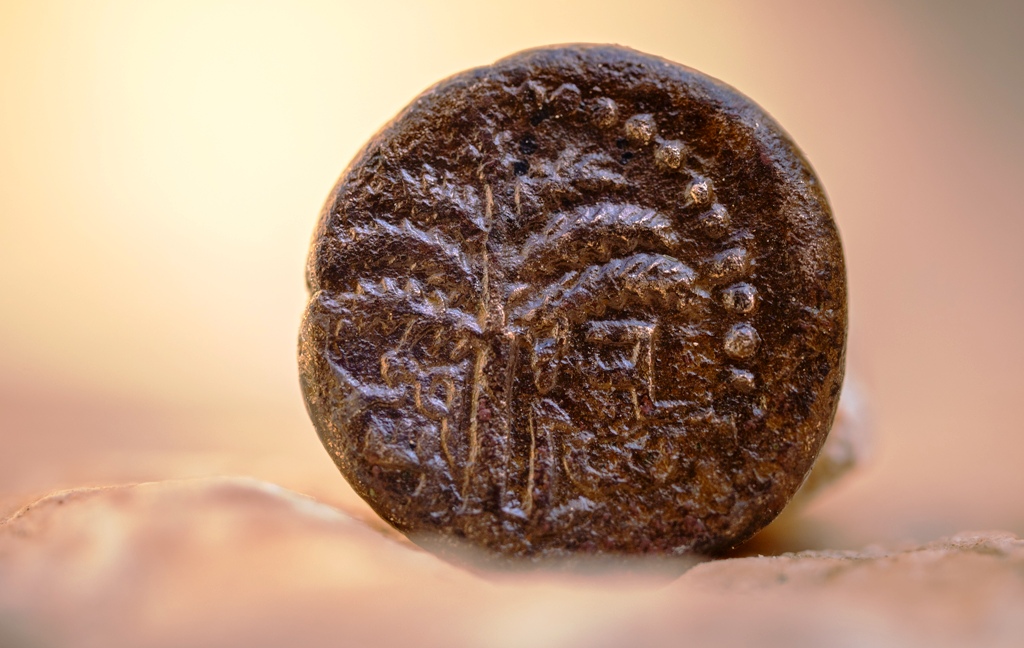A rare coin from the from Bar-Kochba Revolt, the Jews’ revolt against the Roman Empire in 132-136 CE, was recently discovered by Israeli archeologists at the foot of the Temple Mount, north of the City of David.
The rare bronze coin, discovered in the course of archaeological excavations carried out by the Israel Antiquities Authority (IAA) in the William Davidson Archaeological Park, is decorated with a cluster of grapes and the inscription “Year Two of the Freedom of Israel,” and the reverse side features a palm tree and the inscription “Jerusalem.”
This is the only coin from the period of the Bar Kokhba revolt bearing the name “Jerusalem” ever discovered within the Old City of Jerusalem.
Coins from the period of the Bar Kokhba revolt, which declared the rebels’ purpose to liberate Jerusalem from Roman occupation after the destruction of the city in 70 CE are well-known in archeology. Discovering such coins helps researchers map out the revolt.
It is interesting to note that the Jewish rebels minted the coins on Roman coins with stripped or damaged faces, possibly out of defiance of the Roman occupation. The revolt coins featured the Temple facade, trumpets, a harp or violin, as well as the inscriptions “Redemption of Israel” and “Freedom of Israel.”
Dr. Donald Tzvi Ariel, Head of the Coin Department at the IAA, examined over 22,000 coins discovered in archaeological excavations in the area of the Old City in Jerusalem. Only four of the coins are dated to the period of the Bar Kokhba revolt. This is a very small number, even more so when compared to the large number of Bar Kokhba coins that have been found in other areas in Israel.
The Bar Kokhba rebels ultimately failed to reconquer Jerusalem. This fact gives rise to the question of how four coins from the revolt period still made their way into the city.
The excavators, archaeologists Moran Hagbi and Dr. Joe Uziel of the IAA, raise the possibility that the coins were brought to Jerusalem by Roman legionnaires of the Tenth Legion camped in the city, who participated in suppressing the revolt and saved the coins, possibly as souvenirs.
In the archaeological and historical research based on the testimony of the Roman historian Cassius Dio, it is accepted that the Bar Kokhba revolt broke out in 132 CE after Emperor Hadrian declared the establishment of the Roman colony Aelia Capitolina, built on Jerusalem’s ruins. He began with the construction of a temple dedicated to Jupiter on the Temple Mount.
The establishment of the Roman city and the construction of an idolatrous temple in place of the Jewish Temple, in addition to restrictive religious decrees, distressed the Jewish population that had survived the Great Revolt and remained in Judea. This launched a widespread revolt against the Roman government under the leadership of Shimon Ben-Kosiba, known as “Bar Kokhba.”
The revolt lasted about five years, causing heavy casualties among the Roman legions, so extensive that they had to mobilize and redeploy military units from around the Roman Empire to complete their ranks. The revolt ended with the destruction of hundreds of Jewish communities and villages that took part in the revolt.
However, Bar Kokhba remains etched into the memory of the Jewish nation as a historical hero.

No comments:
Post a Comment